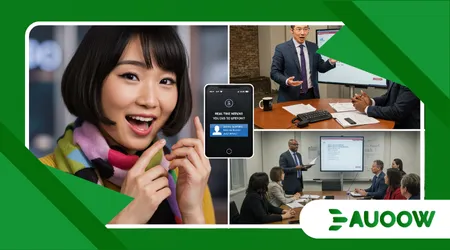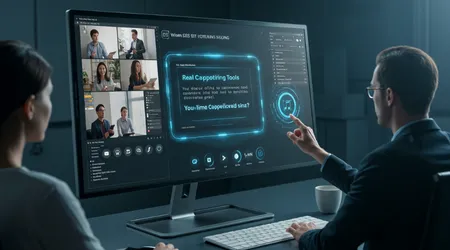Real-Time Captioning Tools You Need to Know About

Real-time captioning tools are revolutionizing accessibility, breaking barriers for the deaf and hard-of-hearing by transforming spoken words into text instantly.
Imagine a world where every conversation, lecture, or livestream is effortlessly inclusive those with hearing impairments can now engage fully, thanks to cutting-edge technology.
In 2025, these tools are not just functional but pivotal in fostering equity across education, workplaces, and entertainment.
This article dives into the latest advancements in real-time captioning tools, exploring their impact, functionality, and transformative potential.
Why should you care about these innovations? Because accessibility is a right, not a privilege, and these tools are shaping a more inclusive future.
From virtual classrooms to corporate boardrooms, the demand for seamless communication has never been higher. According to the National Deaf Center, over 11 million Americans are deaf or hard-of-hearing, underscoring the need for robust assistive technologies.
Real-time captioning tools bridge this gap, ensuring no one is left out of the conversation.
This exploration will cover their evolution, top tools in 2025, practical applications, and future trends, with actionable insights for users and advocates alike.
The Evolution of Real-Time Captioning
Decades ago, accessibility relied on human stenographers, whose speed couldn’t always match the pace of conversation.
Early real-time captioning tools were clunky, error-prone, and limited by processing power. Fast forward to 2025, and artificial intelligence has transformed this landscape.
Machine learning now powers highly accurate speech-to-text algorithms, delivering captions with unprecedented precision.
AI-driven systems like those in real-time captioning tools learn from vast datasets, adapting to accents and jargon in milliseconds.
This leap forward means users experience near-instantaneous transcription, even in noisy environments.
For example, a student named Maria uses captions during lectures to follow complex medical terminology, staying engaged without missing critical details.
++ The Future of Smart Wheelchairs: What’s Coming Next
Yet, challenges remain background noise and overlapping voices can still trip up even the best systems.
Developers are tackling these hurdles with noise-canceling algorithms and multi-speaker detection, pushing the boundaries of what’s possible.
The journey from manual to automated captioning reflects a broader shift toward universal design in technology.

Top Real-Time Captioning Tools in 2025
The market for real-time captioning tools is vibrant, with platforms catering to diverse needs. Microsoft Teams integrates AI-powered captions, supporting 40+ languages with high accuracy.
Its seamless integration with Azure AI makes it a favorite for workplaces, offering captions during virtual meetings.
Google Meet’s live captioning, enhanced by Project Astra, delivers near real-time transcription with tone-matching capabilities.
Also read: How Haptic Feedback Enhances Accessibility in Gaming
This tool shines in multilingual settings, translating captions into 26 languages, as seen in XanderGlasses Connect. A professional like John, attending global conferences, relies on this for instant translations.
Zoom’s captioning feature, bolstered by AI, supports educators and businesses with customizable settings.
It allows users to adjust font size and save transcripts, enhancing accessibility for all. These tools are not just add-ons; they’re integral to inclusive communication.
| Tool | Key Features | Best For | Languages Supported |
|---|---|---|---|
| Microsoft Teams | AI-powered, 40+ languages, Azure integration | Workplaces | 40+ |
| Google Meet | Tone-matching, multilingual, Project Astra | Global conferences | 26+ |
| Zoom | Customizable captions, transcript saving | Education, business | 30+ |
Practical Applications in Everyday Life
In education, real-time captioning tools empower students with hearing impairments. Picture a lecture hall where captions appear on a student’s tablet, syncing perfectly with the professor’s voice.
This technology ensures equal access to knowledge, as seen with Maria’s experience.
Workplaces leverage these tools for inclusivity. A manager named Sarah uses Microsoft Teams’ captions during hybrid meetings, ensuring her deaf colleague follows discussions effortlessly.
This fosters collaboration and breaks down communication barriers in real time.
Entertainment platforms like Netflix now offer dialogue-only captions, complementing traditional real-time captioning tools for immersive viewing.
Read more: How Brain-Computer Interfaces Empower People with Paralysis
Imagine watching a thriller without distracting sound effect cues captions make it possible, enhancing focus for all viewers.
Public events, from town halls to concerts, integrate captions via apps like XanderGlasses, projecting text onto AR displays.
This innovation ensures attendees, like an elderly woman recording a medical seminar, stay engaged and informed.
Challenges and Limitations
No technology is flawless. Real-time captioning tools struggle with accents or specialized jargon, occasionally misinterpreting words.
For instance, a legal seminar’s complex terms might confuse AI, requiring human oversight for accuracy.
Background noise remains a hurdle. In crowded settings, like a bustling café, captions may falter, frustrating users. Developers are countering this with advanced noise-filtering algorithms, but perfection is still elusive.
Cost can also be a barrier. While platforms like Zoom offer free captions, premium features often require subscriptions, limiting access for some. Advocacy for universal free access is growing, pushing for equity in assistive tech.
Privacy concerns arise with cloud-based captioning, where sensitive conversations might be stored. Users must ensure platforms comply with data protection laws, like GDPR, to safeguard personal information.
The Future of Real-Time Captioning
What’s next for real-time captioning tools? The future is bright, with AI advancing toward near-perfect accuracy. Innovations like XanderGlasses Connect hint at wearable captioning, blending AR with real-time transcription for seamless interaction.
Multimodal AI, combining voice, visual, and contextual data, will enhance captioning precision. Imagine a tool that reads lip movements to improve accuracy in noisy environments—a game-changer for accessibility.
Integration with smart devices is expanding. Smart glasses and earbuds, like Halliday’s DigiWindow, project captions directly into the user’s field of view, offering discreet, personalized access. This is like having a personal interpreter in your pocket.
Global accessibility is a priority. Tools are scaling to support more languages and dialects, ensuring inclusivity for diverse communities. The push for open-source platforms will democratize access, fostering innovation.
Why Accessibility Matters

Accessibility isn’t just a feature it’s a necessity. Real-time captioning tools empower millions to participate fully in society, from education to entertainment.
Consider a deaf student named Alex, who uses captions to excel in virtual classes, proving these tools level the playing field.
Beyond compliance, accessibility drives innovation. Companies adopting inclusive tech, like Microsoft’s Azure AI for captioning, see improved employee satisfaction and broader market reach. It’s a win-win for businesses and users.
The ripple effect is profound. Inclusive tools foster empathy, encouraging designers to prioritize universal access. This mindset shift is reshaping technology, making it more human-centered and equitable.
Advocacy plays a critical role. By supporting policies that mandate captioning in public spaces, we ensure no one is excluded. The future depends on collective action to make accessibility a global standard.
Conclusion
Real-time captioning tools are more than technology they’re a lifeline for millions, ensuring no voice goes unheard.
From classrooms to boardrooms, these tools dismantle barriers, fostering inclusion in a fast-paced world.
As AI evolves, so does the promise of universal access, with innovations like AR captions and multimodal AI on the horizon.
The statistic is clear: over 11 million Americans rely on these tools, and their impact is global. By embracing real-time captioning tools, we build a world where everyone belongs.
Let’s advocate, innovate, and ensure accessibility is a reality for all. Isn’t that a future worth creating?
Frequently Asked Questions
Q: How accurate are real-time captioning tools in 2025?
A: Modern tools achieve over 90% accuracy in ideal conditions, but accents and noise can reduce precision, requiring ongoing improvements.
Q: Are real-time captioning tools free to use?
A: Many platforms like Zoom offer free basic captioning, but advanced features often require subscriptions, prompting advocacy for universal access.
Q: Can these tools support multiple languages?
A: Yes, tools like Google Meet support 26+ languages, with AI-driven translation improving accessibility for global users.
Q: How do real-time captioning tools handle privacy?
A: Reputable platforms comply with data protection laws, but users should verify privacy policies to ensure sensitive data remains secure.
